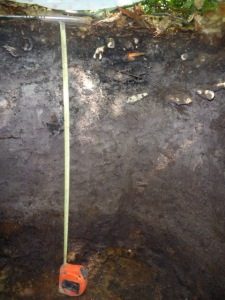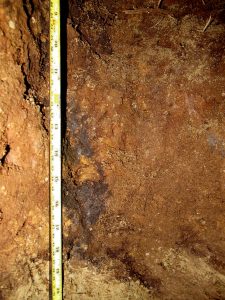
 Last week, JP, Rebecca, Scott, Erik, Phoebe and I were digging soil pits for JP’s project in Watershed 3 at Hubbard Brook. About 10m upslope of these pits we began to dig the first pit for my project on the C horizon. Over the summer, I will be looking at the C horizon and characterizing the soil profiles and the geochemical and hydrologic properties. While digging the deep pit last week, we encountered an interesting discontinuity in the lower B horizon. As pictured, there was a dark streak running down through the lighter Bhs horizon. We were originally puzzled by the presence of this streak. Rebecca suggested that it was most likely a krotovina, an old animal burrow that had been filled in with overlying material. Or perhaps it was an old root tunnel? Regardless, it was interesting to see and got us excited to continue our projects for the summer.
Last week, JP, Rebecca, Scott, Erik, Phoebe and I were digging soil pits for JP’s project in Watershed 3 at Hubbard Brook. About 10m upslope of these pits we began to dig the first pit for my project on the C horizon. Over the summer, I will be looking at the C horizon and characterizing the soil profiles and the geochemical and hydrologic properties. While digging the deep pit last week, we encountered an interesting discontinuity in the lower B horizon. As pictured, there was a dark streak running down through the lighter Bhs horizon. We were originally puzzled by the presence of this streak. Rebecca suggested that it was most likely a krotovina, an old animal burrow that had been filled in with overlying material. Or perhaps it was an old root tunnel? Regardless, it was interesting to see and got us excited to continue our projects for the summer.